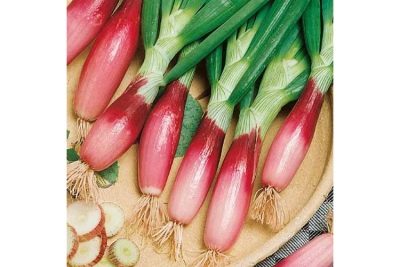
- Authors: Tsiunel M.M., Gavrish S.F., Lezenkova I.M., Gavrish D.S.
- Year of approval: 2013
- Ripening terms: early maturing
- Bulb weight, g: 50-65
- The form: very elongated
- Dry scales: purple
- Coloring juicy scales: white-purple
- Density: medium density
- Taste: semi-sharp
- Disease and pest resistance: above average
Varietal onions Red salad managed to acquire many loyal fans among summer residents. Despite its recent appearance on the market, it has managed to gain popularity due to its early ripeness, versatility of use, and other noticeable advantages. This bow is suitable for planting on an annual cycle in most climates.
Description of the variety
Red salad refers to varieties with good ripening rates. Before harvesting, they are 90%, after ripening - 100%. Small-nesting variety, 1-2 bulbs are formed on 1 stem. The heads are aligned, with an elongated neck. The keeping quality of the onion is good; it is suitable for long-term storage.
Characteristics of the appearance of plants and bulbs
This variety has a compact leaf rosette with dark green feathers. Their texture is juicy and delicate. The bulbs are very elongated, elongated, medium-sized. Their average weight varies in the range from 50 to 65 g, the length reaches 10 cm.Dry scales of purple color, juicy - white-pink, medium density.
Purpose and taste
The variety is considered a salad variety, but is widely used in canning, consumed fresh, frozen for the winter. The taste of feathers and heads is assessed as pleasant, semi-sharp.
Maturation
The red salad variety belongs to the early ripening onion varieties. From germination to harvest, 100-110 days pass.
Yield
The average collection volume is 353 c / ha. According to this indicator, onions are high-yielding.
Growing regions
The variety is intended for cultivation in the Central region of the Russian Federation and nearby regions.
Planting dates with seeds, seedlings and seedlings
Seeds are sent to the ground at the end of April, as well as sevok. It is worth focusing on the weather and climatic norms, while waiting for the soil to warm up. With the seedling method of growing, they are sown in March, and the plants are transferred to open beds in May.
Growing and caring
This onion variety is recommended for growing in an annual crop, with sowing seeds and obtaining a turnip during the season. To increase the final size of the bulbs, it is recommended to pre-distill the seedlings. Sowing, regardless of the chosen method, is done to a depth of 1-1.5 cm in compliance with the 5 × 20 cm scheme.
Frequent watering is not required for this onion. As the rosette and heads grow, the soil in the ridges or containers with seedlings is moistened as needed, on average once a week. With a strong drying out of the soil, irrigation is increased, during the period of heavy rains, it is made more rare. The soil is loosened weekly in the aisles, making it permeable for air flow to the roots.
Top dressing for this variety needs regular, but moderate. For the first time, fertilizers in the form of poorly diluted cow dung are given 2 weeks after germination. At the stage of turnip formation, potassium-phosphorus mixtures are used. Such a scheme will ensure the absence of a large amount of nitrates in the crop.

Since the onion is an unpretentious and cold-resistant plant, it can be planted both in spring and autumn. It is necessary to properly prepare the planting material, competently prepare the garden bed and determine the timing of planting.

Soil requirements
Best of all, this variety of onions grows on fertile, moist loams, sandy loams. High acidity of the soil or excess lime is contraindicated for it. If necessary, the pH value is adjusted artificially.

The bow is not as unpretentious as it seems. For good growth, you need fertile soil, quality care and nutritious fertilizers. Without top dressing, the bulbs will grow small, and the greens will not be lush. At different stages, it should be fed with different substances. The vegetable needs organic and mineral feeding. A good result for fertilizing onions is the use of folk remedies.
Required climatic conditions
Red Salad Onion is well adapted to growing in adverse weather conditions. He needs a lot of sun, does not respond well to strong shading. But at the same time it tolerates light frosts, successfully copes with drought.
Disease and pest resistance
The variety is perfectly protected from garden pests, fungi and viruses. Its resistance to the influence of these factors is assessed above average.

Despite the fact that the onion is a very useful plant, capable of repelling and killing many microbes and bacteria, it itself is often damaged and suffers from various misfortunes. Diseases and pests of onions can significantly reduce the yield. It is necessary to correctly determine the presence of this or that disease and take appropriate measures in time.
Review overview
Red lettuce, according to gardeners, fully justifies its name. Due to the content of nutrients, it is an excellent addition to the main diet. Summer residents note the moderate pungency and attractive color of the bulbs, their bright color. The early maturity of the variety is considered a big advantage, the harvest is harvested long before the onset of cold weather. There are already reviews that this onion is successfully grown in many other regions of the Russian Federation, including the Urals, but with the obligatory distillation of seedlings.
The disadvantages of this variety of red onions include the unusual shape of the heads, it is close to spindle-shaped, which some summer residents do not like too much. The small size is also disappointing. This is not a giant onion, but a variety with rather modest performance, but with excellent taste.


















































































